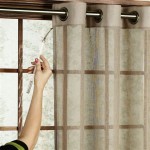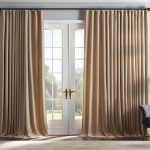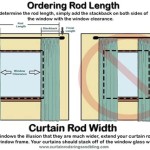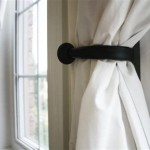Curtain Pole Attached To Ceiling: A Comprehensive Guide
Attaching a curtain pole to the ceiling presents a viable and often advantageous alternative to traditional wall-mounted installations. This method offers a clean, minimalist aesthetic, maximizes light penetration, and provides solutions for challenging window placements or architectural designs. This article will explore the benefits, considerations, and installation process of attaching a curtain pole directly to the ceiling.
The decision to mount a curtain pole to the ceiling often stems from specific architectural or functional needs. Windows positioned close to the ceiling, limited wall space, or the desire for a floor-to-ceiling curtain effect are common drivers. Understanding the nuances of this mounting method is crucial for a successful and aesthetically pleasing outcome.
Proper planning and preparation are paramount before commencing the installation. This involves assessing the ceiling material, selecting appropriate hardware, and accurately measuring the desired curtain pole position. Incorrect execution can lead to structural damage and compromised curtain functionality.
Benefits of Ceiling-Mounted Curtain Poles
Ceiling-mounted curtain poles offer a range of benefits over traditional wall-mounted options. Primarily, they create the illusion of increased height within a room. By drawing the eye upward, the floor-to-ceiling curtain design can make a space feel larger and more open. This is particularly effective in rooms with lower ceilings.
Another significant advantage is the maximization of natural light. By positioning the curtain track close to the ceiling, it minimizes the amount of window obscured by the curtain pole and hardware. This allows more sunlight to enter the room, improving illumination and reducing the need for artificial lighting.
Furthermore, ceiling mounts provide a solution for challenging window placements. In situations where windows are positioned very close to the ceiling, or where architectural features prevent traditional wall mounting, a ceiling-mounted curtain pole offers a practical and aesthetically pleasing alternative. This is particularly relevant in modern architecture with expansive windows and minimalist designs.
Architectural considerations are also relevant. In some cases, crown molding, built-in shelves, or other wall-mounted features can obstruct the installation of wall-mounted curtain brackets. A ceiling-mounted pole bypasses these obstacles, allowing for a seamless and unobstructed curtain installation.
Finally, ceiling-mounted curtain poles contribute to a cleaner, more minimalist aesthetic. The absence of visible wall brackets creates a streamlined look, emphasizing the curtain fabric and overall design of the room. This minimalist approach is particularly popular in contemporary interiors.
Considerations Before Installation
Before proceeding with the installation, a thorough assessment of several factors is essential. The type of ceiling material is arguably the most crucial consideration. Drywall, plaster, concrete, and wood each require different types of anchors and installation techniques. Identifying the ceiling material accurately is the first step in ensuring a secure and stable installation.
Drywall ceilings require specialized anchors designed to grip the gypsum board securely. These anchors typically include drywall anchors, toggle bolts, or molly bolts. The weight capacity of the chosen anchor must be sufficient to support the curtain pole and curtains, taking into account the potential weight of heavier fabrics. Overloading drywall anchors can lead to them pulling out of the ceiling, causing damage and potential hazards.
Plaster ceilings present similar challenges to drywall, but often require a more delicate approach due to the brittle nature of plaster. Pre-drilling pilot holes is crucial to avoid cracking the plaster. Anchors specifically designed for plaster, such as plaster screws or expansion anchors, provide a more secure hold. It is important to avoid over-tightening the screws, as this can also cause the plaster to crack.
Concrete ceilings offer the most robust mounting surface; however, they require specialized tools and techniques. A hammer drill is necessary to create the pilot holes, and concrete anchors, such as wedge anchors or sleeve anchors, are essential for a secure hold. Safety precautions, including wearing eye protection, are paramount when drilling into concrete.
Wood ceilings, such as those found in older homes or with exposed beams, provide a relatively straightforward mounting surface. Wood screws can be used directly to attach the curtain pole brackets to the wood. However, it is important to ensure that the wood is solid and free from rot or decay. If the wood is soft or damaged, it may be necessary to reinforce it before installing the curtain pole.
Beyond the ceiling material, the weight of the curtains is another critical factor. Heavier fabrics, such as blackout curtains or lined drapes, will require more robust anchors and brackets. Calculating the approximate weight of the curtains ensures that the chosen hardware is adequate to support the load. Failing to account for the weight of the curtains can lead to sagging or even complete failure of the installation.
The span of the curtain pole also influences the requirements for support. Longer curtain poles will require more support brackets to prevent sagging. The recommended spacing between brackets varies depending on the weight of the curtains and the material of the pole, typically ranging from 3 to 4 feet. Proper bracket placement is crucial for maintaining the structural integrity of the installation.
Finally, the desired aesthetic should also be considered. Different types of brackets are available, ranging from simple and functional to decorative and ornate. Selecting brackets that complement the overall design of the room ensures a cohesive and visually appealing result. The color and finish of the pole and brackets should also be carefully considered to match the existing decor.
Installation Process: Step-by-Step Guide
The installation process of a ceiling-mounted curtain pole requires precision and attention to detail. Proper measurement and marking are crucial to ensure accurate bracket placement and a level curtain pole.
The first step is to determine the desired location of the curtain pole. This involves measuring the window width and marking the points where the brackets will be attached to the ceiling. It is important to use a level to ensure that the marks are aligned and that the curtain pole will hang straight.
Next, the type of anchors required must be determined based on the ceiling material. As previously discussed, different anchors are necessary for drywall, plaster, concrete, and wood. Ensure that the correct type of anchor is selected and that it is rated to support the weight of the curtains and pole.
Once the anchors are chosen, pilot holes must be drilled at the marked locations. The size of the pilot hole should be slightly smaller than the diameter of the anchor. For drywall and plaster, it is important to use a gentle touch to avoid cracking the ceiling material. For concrete, a hammer drill and appropriate drill bit are required.
After the pilot holes are drilled, the anchors can be inserted into the holes. Follow the manufacturer's instructions for the specific type of anchor being used. Some anchors require hammering into place, while others require tightening with a screwdriver or wrench. Ensure that the anchors are securely fastened to the ceiling.
With the anchors in place, the curtain pole brackets can be attached. Align the brackets with the anchors and screw them into place. Ensure that the screws are tightened securely, but avoid over-tightening, which can damage the ceiling material or strip the screw threads.
Finally, the curtain pole can be inserted into the brackets. Most curtain poles have a locking mechanism to secure them in place. Ensure that the pole is properly seated in the brackets and that the locking mechanism is engaged.
After the curtain pole is installed, hang the curtains and test the functionality. Ensure that the curtains glide smoothly along the pole and that the brackets are able to support the weight of the curtains without sagging. Make any necessary adjustments to the bracket placement or anchor tightness to ensure a secure and stable installation.
Regular maintenance of the ceiling-mounted curtain pole is important to ensure its longevity and functionality. Periodically check the anchors and brackets for looseness and tighten them as needed. Dust the curtain pole and curtains regularly to prevent the buildup of dust and debris. Addressing any issues promptly will prevent more significant problems from developing over time.
By carefully considering these factors and following the installation process, a ceiling-mounted curtain pole can provide a stylish and functional window treatment solution that enhances the aesthetics and functionality of any room. The clean lines, maximized light penetration, and adaptability to challenging window placements make it a compelling alternative to traditional wall-mounted options.

How To Hang Curtains From The Ceiling Deconovo Us

Hanging Curtains From The Ceiling Home

How To Hang Curtains With Crown Molding The Shade

Bradleys 25mm Ceiling Fix Bay Window Curtain Pole And Morris Co Forest Velvet Curtains Installed In North London By Changing

Ceiling Brackets To Hang Curtains Hanging Curtain Rods

Diy Ceiling Mounted Curtain Rods With Step By Instructions Simplified Building

Custom Curtain Rails Ceiling Wall Installation Mhz

How To Diy A Ceiling Mounted Shower Rod First Gen House

Custom Curtain Rails Ceiling Wall Installation Mhz

Emoh Heavy Duty 1 In Dia Ceiling Mounted 90 Curved Corner Single Curtain Track 8 Ft Hat39 24 8ft L The Home








